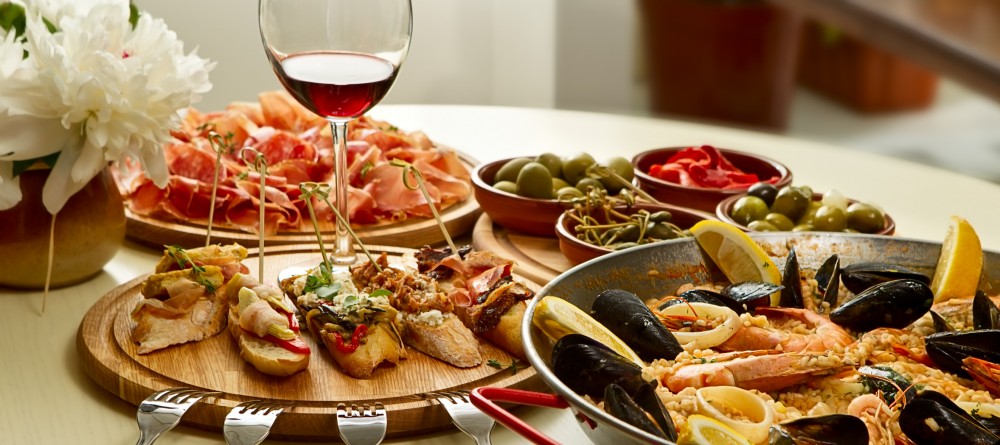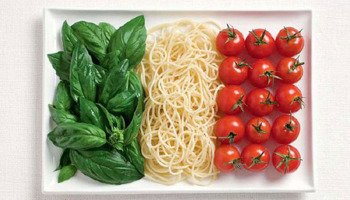Food and Wine
Food
Italian cuisine has a great variety of different ingredients which are commonly used, ranging from fruits, vegetables, sauces, meats, etc. In the North of Italy, fish (such as cod, or baccalà), potatoes, rice, corn (maize), sausages, pork, and different types of cheeses are the most common ingredients. Pasta dishes with use of tomato are spread in all Italy.
Food and Wine Made in Italy
In Northern Italy though there are many kinds of stuffed pasta, polenta and risotto are equally popular if not more so. Ligurian ingredients include several types of fish and seafood dishes; basil (found in pesto), nuts and olive oil are very common. In Emilia-Romagna, common ingredients include ham (prosciutto), sausage (cotechino), different sorts of salami, truffles, grana, Parmigiano-Reggiano, and tomatoes (Bolognese sauce or ragù).
Traditional Central Italian cuisine uses ingredients such as tomatoes, all kinds of meat, fish, and pecorino cheese. In Tuscany and Umbria pasta is usually served alla carrettiera (a tomato sauce spiked with peperoncini hot peppers).[32] Finally, in Southern Italy, tomatoes – fresh or cooked into tomato sauce – peppers, olives and olive oil, garlic, artichokes, oranges, ricotta cheese, eggplants, zucchini, certain types of fish (anchovies, sardines and tuna), and capers are important components to the local cuisine.
Our products are 100% Italian. We are proud to advocate transparency on the manufacturing process of all products, on the organic production of food and its location origin that we certify and on the strictest health regulation that the Italian health law provide to keep the quality of our products to the highest level.
Italian Food Made In Italy
Italian cuisine is also well known (and well regarded) for its use of a diverse variety of pasta. Pasta include noodles in various lengths, widths and shapes. Distinguished on shapes they are named — penne, maccheroni, spaghetti, linguine, fusilli, lasagne and many more varieties that are filled with other ingredients like ravioli and tortellini.
The word pasta is also used to refer to dishes in which pasta products are a primary ingredient. It is usually served with sauce. There are hundreds of different shapes of pasta with at least locally recognized names.
Examples include spaghetti (thin rods), rigatoni (tubes or cylinders), fusilli (swirls), and lasagne (sheets). Dumplings, like gnocchi (made with potatoes) and noodles like spätzle, are sometimes considered pasta. They are both traditional in parts of Italy.
Pasta is categorized in two basic styles: dried and fresh. Dried pasta made without eggs can be stored for up to two years under ideal conditions, while fresh pasta will keep for a couple of days in the refrigerator. Pasta is generally cooked by boiling. Under Italian law, dry pasta (pasta secca) can only be made from durum wheat flour or durum wheat semolina, and is more commonly used in Southern Italy compared to their Northern counterparts, who traditionally prefer the fresh egg variety.
Durum flour and durum semolina have a yellow tinge in color. Italian pasta is traditionally cooked al dente (Italian: “firm to the bite”, meaning not too soft). Outside Italy, dry pasta is frequently made from other types of flour, but this yields a softer product that cannot be cooked al dente. There are many types of wheat flour with varying gluten and protein depending on variety of grain used.
Particular varieties of pasta may also use other grains and milling methods to make the flour, as specified by law. Some pasta varieties, such as pizzoccheri, are made from buckwheat flour. Fresh pasta may include eggs (pasta all’uovo ‘egg pasta’). Whole wheat pasta has become increasingly popular because of its supposed health benefits over pasta made from refined flour.
WINE Made in Italy
Italy is home to some of the oldest wine-producing regions in the world, and Italian wines are known worldwide for their broad variety. Italy, closely followed by France, is the world’s largest wine producer by volume. Its contribution is about 45–50 million hl per year, and represents about ⅓ of global production. Italian wine is exported around the world and is also extremely popular in Italy: Italians rank fifth on the world wine consumption list by volume with 42 litres per capita consumption. Grapes are grown in almost every region of the country and there are more than one million vineyards under cultivation.
Etruscans and Greek settlers produced wine in Italy before the Romans started their own vineyards in the 2nd century B.C. Roman grape-growing and winemaking was prolific and well-organized, pioneering large-scale production and storage techniques like barrel-making and bottling.
Italy is the world’s largest or second largest wine producer. In 2005, production was about 20% of the global total, second only to France, which produced 26%. In the same year, Italy’s share in dollar value of table wine imports into the U.S. was 32%, Australia’s was 24%, and France’s was 20%. Along with Australia, Italy’s market share has rapidly increased in recent years.
It’s no coincidence that some of the loveliest places on the planet to vacation are also the places where wine is grown. Temperate climates and rolling, vine-covered hills are good for both grapes and people, it seems.
Food and Wine Made in Italy
Choose which wineries to visit by the experiences they offer. Great Italy suggests visiting no more than three wineries in a day, and picking ones that explore different areas of wine culture and try to craft different experiences. So, at one winery you might learn about wine making, at another you’ll learn about vineyards and the growth of grapes, at another the experience might be more about food and wine pairings, or the wonderful art and architecture at the winery. Some wineries are even hosting music festivals, and allowing guests to custom blend their own bottles. Fall is grape harvest time and a wonderful excuse to improve your knowledge of Italian wines or just to ‘wine-bar’ hop in Rome, Florence and Milan.


